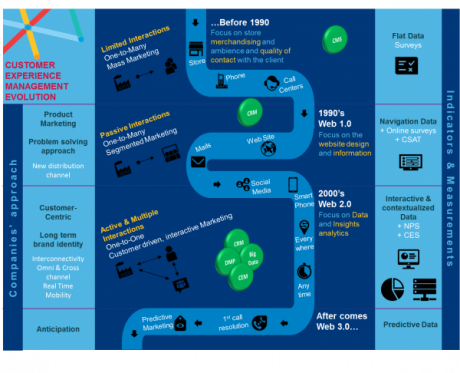
A Rapidly Changing Landscape
Customer experience management by companies and brands is evolving rapidly.
The technological revolution and the rise of digital tools have profoundly transformed both business operations and personal lifestyles, reshaping expectations, behaviors, and the possibilities for engagement.
The Age of “One-to-Many”
In the late 1980s, mass marketing was seen as a revolutionary concept that allowed companies to communicate with all customers — the famous "one-to-many" model.
Customer experience management was limited to key touchpoints: physical stores, telephone reception, and call centers. The focus was on providing a welcoming and high-quality environment.
To evaluate their performance, companies relied on phone surveys to gather customer feedback on their experience.
The Rise of the Internet and the CSAT
In the early 1990s, the democratization of the Internet introduced a new mode of interaction between brands and customers.
It opened opportunities for new communication and distribution channels and for collecting customer insights — but also added complexity.
Websites made product information (and competitor offerings!) more easily accessible.
Companies had to optimize this new interface to stand out and gather data on their users.
These new insights allowed businesses to segment customers and tailor products and services — the golden era of product marketing.
However, communication remained one-way: companies spoke, and customers listened.
To support this strategy, businesses adopted CRM solutions (Customer Relationship Management) to better manage and analyze client data.
New customer satisfaction metrics also emerged, including the evolution of the online satisfaction survey and the Customer Satisfaction Score (CSAT) — a metric that assesses short-term satisfaction using a scale from 1 to 5.
Web 2.0 and Smartphones: The Customer Experience Revolution
From the 2000s, the Internet entered a new phase with the Web 2.0 era, defined by the rise of social media.
Just like the early days of the Internet, this tech leap created both new opportunities and new challenges.
Communication was no longer one-directional but multi-directional.
Consumers became active participants, engaging not only with brands but also with other users.
From then on, customer experience became a major competitive differentiator in business strategy.
Marketing increasingly shifted from a product-centric to a customer-centric approach.
This gave rise to one-to-one marketing strategies, now favored over the traditional one-to-many model.
Smartphones further disrupted the landscape by introducing mobility, geolocation, and real-time interaction.
This marked the start of the multi-screen era, requiring companies to manage multiple channels and synchronize them to deliver a seamless, omnichannel customer journey.
Once again, technology rose to the challenge, with more powerful CRMs, the advent of Big Data, and Data Management Platforms (DMPs) capable of handling the massive amount of user data generated online.
NPS and CES: New Standards in Customer Experience Metrics
These vast data streams could now be sorted, connected, and used to enhance customer experience quality.
To measure it, new indicators emerged — most notably the NPS (Net Promoter Score) and the CES (Customer Effort Score).
Introduced in 2003, NPS measures a customer’s likelihood to recommend a product, service, or brand — unlike CSAT, which evaluates satisfaction on a specific action.
It offers greater predictive power for customer behavior.
Seven years later, the CES appeared, evaluating how much effort a customer must make to interact with the brand — another essential perspective on the experience.
What’s Next? Predictive Marketing and Beyond
What comes next? Only time will tell, but the trend points to anticipation and predictive marketing.
What if companies could solve a customer’s problem before they even reach out to customer service? That would dramatically enhance the experience.
Moreover, just like an osteopath who treats neck pain by adjusting the spine, businesses must look beyond direct touchpoints to improve customer experience.
They must also address infrastructure, processes, human resources, brand identity, and more — because improvements in these areas amplify customer satisfaction in powerful ways.
CRM (Customer Relationship Management): tools that optimize client relationships by analyzing data and supporting marketing actions aimed at loyalty building.
The article “The Evolution of Customer Experience Management” first appeared on Sofrecom.




